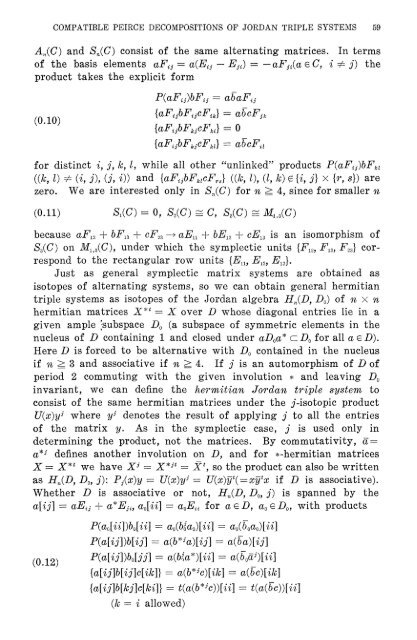Compatible Peirce decompositions of Jordan triple systems - MSP
Compatible Peirce decompositions of Jordan triple systems - MSP
Compatible Peirce decompositions of Jordan triple systems - MSP
You also want an ePaper? Increase the reach of your titles
YUMPU automatically turns print PDFs into web optimized ePapers that Google loves.
COMPATIBLE PEIRCE DECOMPOSITIONS OF JORDAN TRIPLE SYSTEMS 59<br />
A n(C) and S n(C) consist <strong>of</strong> the same alternating matrices. In terms<br />
<strong>of</strong> the basis elements aF i3 — a(E i3 — E H) = — aF 3i(a eC, i Φ j) the<br />
product takes the explicit form<br />
P(aF ί3)bF i3<br />
= abaF i3<br />
{aF i3bF ί3cF ik} = abcF jk<br />
' {aF iόbF k3cF ki} = 0<br />
{aF i3bF k3 cF kl} = abcF u<br />
for distinct i, j, k, I, while all other "unlinked" products P(aF i3)bF kl<br />
((fc, I) ^ (if j), ϋ, ϋ) and {aF ί3bF klcF rs} ((fc, Z), (Z, fc) g {i, j} x {r, s}) are<br />
zero. We are interested only in S n(C) for n ^ 4, since for smaller n<br />
(0.11) ^(C) = 0, S 2(C) = C,<br />
because aF12 + δi^is + oF2d —> a£/ n + δί? 12 + cJ513 is an isomorphism <strong>of</strong><br />
S3(C) on MltB(C), under which the symplectic units {F12, F1S, F23} correspond<br />
to the rectangular row units {En, Ei2, E13\. Just as general symplectic matrix <strong>systems</strong> are obtained as<br />
isotopes <strong>of</strong> alternating <strong>systems</strong>, so we can obtain general hermitian<br />
<strong>triple</strong> <strong>systems</strong> as isotopes <strong>of</strong> the <strong>Jordan</strong> algebra Hn(D, Do) <strong>of</strong> n x n<br />
hermitian matrices X** — X over D whose diagonal entries lie in a<br />
given ample -subspace Do (a subspace <strong>of</strong> symmetric elements in the<br />
nucleus <strong>of</strong> D containing 1 and closed under aDoa* czD0 for all aeD).<br />
Here D is forced to be alternative with Do contained in the nucleus<br />
if n ^ 3 and associative if n ^ 4. If j is an automorphism <strong>of</strong> D <strong>of</strong><br />
period 2 commuting with the given involution * and leaving Dϋ invariant, we can define the hermitian <strong>Jordan</strong> <strong>triple</strong> system to<br />
consist <strong>of</strong> the same hermitian matrices under the ^-isotopic product<br />
U(x)y j<br />
where y j<br />
denotes the result <strong>of</strong> applying j to all the entries<br />
<strong>of</strong> the matrix y. As in the symplectic case, j is used only in<br />
determining the product, not the matrices. By commutativity, a —<br />
a* 3<br />
defines another involution on D, and for *-hermitian matrices<br />
X = X** we have X 3<br />
' = X* jt<br />
— X*, so the product can also be written<br />
as Hn (D, A, j)' Pj(%)y = U{x)y 3<br />
' — U(x)y t<br />
( = xy t<br />
x if D is associative).<br />
Whether D is associative or not, Hn (Dy DQ , j) is spanned by the<br />
a[ij] — aEί3 + a*Ejif aQ [ii] = a0Eu for αeΰ, α0 e Do , with products<br />
] = a Q (bia Q )[ii] = a Q (b Q a Q )[ii]<br />
= a(b*'a)[if\ = a(ba)[ij]<br />
(0.12) p (ΦJ]MJJ] = α(6ία*)[ii] = a(b a o j )[ii]<br />
{[]b[j][k]} = a{b* {b*')[k] (b)[ik]<br />
3<br />
'c)[ik] = a(bc)[ik]<br />
(k — i allowed)<br />
= t(a(b* 3 'c))[ii] =













